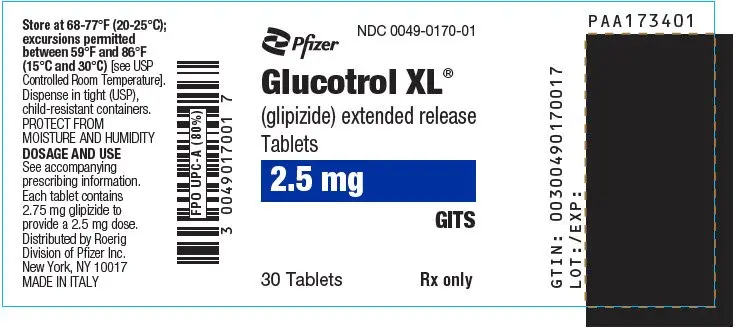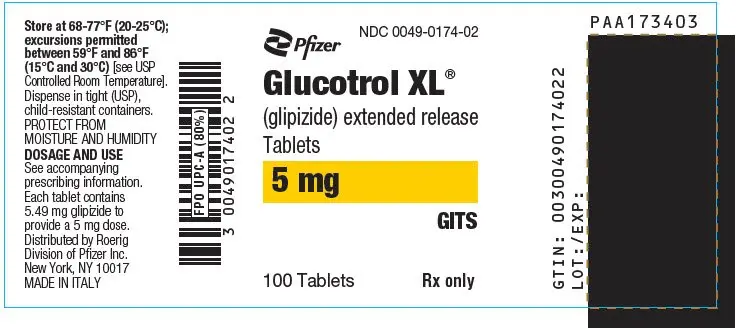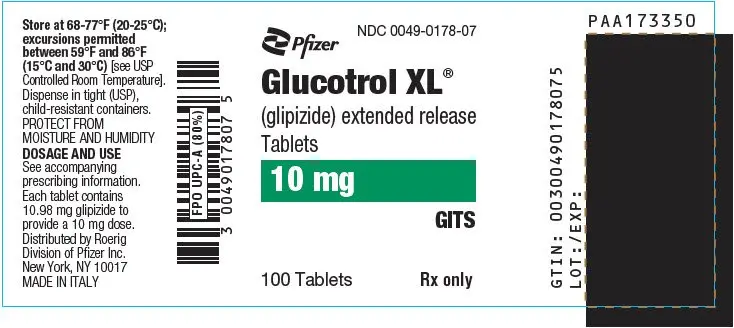Drug Detail:Glucotrol xl (Glipizide [ glip-i-zide ])
Drug Class: Sulfonylureas
Highlights of Prescribing Information
GLUCOTROL XL® (glipizide) extended release tablets, for oral use
Initial U.S. Approval: 1994
Indications and Usage for Glucotrol XL
GLUCOTROL XL is a sulfonylurea indicated as an adjunct to diet and exercise to improve glycemic control in adults with type 2 diabetes mellitus (1)
Limitations of Use: Not for treatment of type 1 diabetes or diabetic ketoacidosis (1)
Glucotrol XL Dosage and Administration
- Recommended starting dose is 5 mg once daily. Dose adjustment can be made based on the patient's glycemic control. Maximum recommended dose is 20 mg once daily (2.1).
- Administer with breakfast or the first meal of the day (2.1).
- For combination therapy with other blood-glucose-lowering agents, initiate the agent at the lowest recommended dose, and observe patients for hypoglycemia (2.2).
Dosage Forms and Strengths
Tablets: 2.5 mg, 5 mg, 10 mg (3).
Contraindications
- Known hypersensitivity to glipizide or any of the product's ingredients (4).
- Hypersensitivity to sulfonamide derivatives (4).
Warnings and Precautions
- Hypoglycemia: May be severe. Ensure proper patient selection, dosing, and instructions, particularly in at-risk populations (e.g., elderly, renally impaired) and when used with other anti-diabetic medications (5.1).
- Hemolytic Anemia: Can occur if glucose 6-phosphate dehydrogenase (G6PD) deficient. Consider a non-sulfonylurea alternative (5.2).
- Potential Increased Risk of Cardiovascular Mortality with Sulfonylureas: Inform patient of risks, benefits and treatment alternatives (5.3).
- Macrovascular Outcomes: No clinical studies have established conclusive evidence of macrovascular risk reduction with GLUCOTROL XL or any other anti-diabetic drug (5.4).
Adverse Reactions/Side Effects
Most common adverse reactions (incidence > 3%) are dizziness, diarrhea, nervousness, tremor, hypoglycemia and flatulence (6.1).
To report SUSPECTED ADVERSE REACTIONS, contact Pfizer, Inc. at 1-800-438-1985 or FDA at 1-800-FDA-1088 or www.fda.gov/medwatch.
Drug Interactions
- Certain medications may affect glucose metabolism, requiring GLUCOTROL XL dose adjustment and close monitoring of blood glucose (7.1).
- Miconazole: Monitor patients closely. Severe hypoglycemia can occur when GLUCOTROL and oral miconazole are used concomitantly (7.2, 12.3).
- Fluconazole: Monitor patients closely. An increase in GLUCOTROL AUC was seen after fluconazole administration (7.3, 12.3).
- Colesevelam: GLUCOTROL XL should be administered at least 4 hours prior to colesevelam (7.4, 12.3).
Use In Specific Populations
- Geriatric, Hepatically Impaired Patients: At risk for hypoglycemia with GLUCOTROL XL. Use caution in dose selection and titration, and monitor closely (8.5, 8.6).
See 17 for PATIENT COUNSELING INFORMATION and FDA-approved patient labeling.
Revised: 11/2021
Full Prescribing Information
1. Indications and Usage for Glucotrol XL
GLUCOTROL XL is indicated as an adjunct to diet and exercise to improve glycemic control in adults with type 2 diabetes mellitus.
2. Glucotrol XL Dosage and Administration
2.1 Recommended Dosing
GLUCOTROL XL should be administered orally with breakfast or the first main meal of the day.
The recommended starting dose of GLUCOTROL XL is 5 mg once daily. Start patients at increased risk for hypoglycemia (e.g. the elderly or patients with hepatic insufficiency) at 2.5 mg [see Use in Specific Population (8.5, 8.6)].
Dosage adjustment can be made based on the patient's glycemic control. The maximum recommended dose is 20 mg once daily.
Patients receiving immediate release glipizide may be switched to GLUCOTROL XL once daily at the nearest equivalent total daily dose.
2.2 Use with Other Glucose Lowering Agents
When adding GLUCOTROL XL to other anti-diabetic drugs, initiate GLUCOTROL XL at 5 mg once daily. Start patients at increased risk for hypoglycemia at a lower dose.
When colesevelam is coadministered with glipizide ER, maximum plasma concentration and total exposure to glipizide is reduced. Therefore, GLUCOTROL XL should be administered at least 4 hours prior to colesevelam.
3. Dosage Forms and Strengths
GLUCOTROL XL (glipizide) Extended Release tablets:
2.5 mg, blue and imprinted with "GLUCOTROL XL 2.5" or "GXL 2.5" on one side
5 mg, white and imprinted with "GLUCOTROL XL 5" or "GXL 5" on one side
10 mg, white and imprinted with "GLUCOTROL XL 10" or "GXL 10" on one side
4. Contraindications
Glipizide is contraindicated in patients with:
- Known hypersensitivity to glipizide or any of the product's ingredients.
- Hypersensitivity to sulfonamide derivatives.
5. Warnings and Precautions
5.1 Hypoglycemia
All sulfonylurea drugs, including GLUCOTROL XL, are capable of producing severe hypoglycemia [see Adverse Reactions (6)]. Concomitant use of GLUCOTROL XL with other anti-diabetic medication can increase the risk of hypoglycemia. A lower dose of GLUCOTROL XL may be required to minimize the risk of hypoglycemia when combining it with other anti-diabetic medications.
Educate patients to recognize and manage hypoglycemia. When initiating and increasing GLUCOTROL XL in patients who may be predisposed to hypoglycemia (e.g., the elderly, patients with renal impairment, patients on other anti-diabetic medications) start at 2.5 mg. Debilitated or malnourished patients, and those with adrenal, pituitary, or hepatic impairment are particularly susceptible to the hypoglycemic action of anti-diabetic medications. Hypoglycemia is also more likely to occur when caloric intake is deficient, after severe or prolonged exercise, or when alcohol is ingested.
The patient's ability to concentrate and react may be impaired as a result of hypoglycemia. Early warning symptoms of hypoglycemia may be different or less pronounced in patients with autonomic neuropathy, the elderly, and in patients who are taking beta-adrenergic blocking medications or other sympatholytic agents. These situations may result in severe hypoglycemia before the patient is aware of the hypoglycemia.
These impairments may present a risk in situations where these abilities are especially important, such as driving or operating other machinery. Severe hypoglycemia can lead to unconsciousness or convulsions and may result in temporary or permanent impairment of brain function or death.
5.2 Hemolytic Anemia
Treatment of patients with glucose 6-phosphate dehydrogenase (G6PD) deficiency with sulfonylurea agents, including GLUCOTROL XL, can lead to hemolytic anemia. Avoid use of GLUCOTROL XL in patients with G6PD deficiency. In post marketing reports, hemolytic anemia has also been reported in patients who did not have known G6PD deficiency.
5.3 Increased Risk of Cardiovascular Mortality with Sulfonylureas
The administration of oral hypoglycemic drugs has been reported to be associated with increased cardiovascular mortality as compared to treatment with diet alone or diet plus insulin. This warning is based on the study conducted by the University Group Diabetes Program (UGDP), a long-term prospective clinical trial designed to evaluate the effectiveness of glucose-lowering drugs in preventing or delaying vascular complications in patients with type 2 diabetes mellitus. The study involved 823 patients who were randomly assigned to one of four treatment groups.
UGDP reported that patients treated for 5 to 8 years with diet plus a fixed dose of tolbutamide (1.5 grams per day) had a rate of cardiovascular mortality approximately 2½ times that of patients treated with diet alone. A significant increase in total mortality was not observed, but the use of tolbutamide was discontinued based on the increase in cardiovascular mortality, thus limiting the opportunity for the study to show an increase in overall mortality. Despite controversy regarding the interpretation of these results, the findings of the UGDP study provide an adequate basis for this warning. The patient should be informed of the potential risks and advantages of glipizide and of alternative modes of therapy.
Although only one drug in the sulfonylurea class (tolbutamide) was included in this study, it is prudent from a safety standpoint to consider that this warning may also apply to other oral hypoglycemic drugs in this class, in view of their close similarities in mode of action and chemical structure.
5.4 Macrovascular Outcomes
There have been no clinical studies establishing conclusive evidence of macrovascular risk reduction with GLUCOTROL XL or any other anti-diabetic drug.
5.5 Gastrointestinal Obstruction
There have been reports of obstructive symptoms in patients with known strictures in association with the ingestion of another drug with this non-dissolvable extended release formulation. Avoid use of GLUCOTROL XL in patients with preexisting severe gastrointestinal narrowing (pathologic or iatrogenic).
6. Adverse Reactions/Side Effects
The following serious adverse reactions are discussed in more detail below and elsewhere in the labeling:
- Hypoglycemia [see Warnings and Precautions (5.1)]
- Hemolytic anemia [see Warnings and Precautions (5.2)]
6.1 Clinical Trials Experience
Because clinical trials are conducted under widely varying conditions, adverse reaction rates observed in the clinical trials of a drug cannot be directly compared to rates in the clinical trials of another drug and may not reflect the rates observed in practice.
In clinical trials, 580 patients from 31 to 87 years of age received GLUCOTROL XL in doses from 5 mg to 60 mg in both controlled and open trials. The dosages above 20 mg are not recommended dosages. In these trials, approximately 180 patients were treated with GLUCOTROL XL for at least 6 months.
Table 1 summarizes the incidence of adverse reactions, other than hypoglycemia, that were reported in pooled double-blind, placebo-controlled trials in ≥3% of GLUCOTROL XL-treated patients and more commonly than in patients who received placebo.
| GLUCOTROL XL (%) (N=278) | Placebo (%) (N=69) |
|
|---|---|---|
| Adverse Effect | ||
| Dizziness | 6.8 | 5.8 |
| Diarrhea | 5.4 | 0.0 |
| Nervousness | 3.6 | 2.9 |
| Tremor | 3.6 | 0.0 |
| Flatulence | 3.2 | 1.4 |
6.2 Postmarketing Experience
The following adverse reactions have been identified during post approval use of GLUCOTROL XL. Because these reactions are reported voluntarily from a population of uncertain size, it is not always possible to reliably estimate their frequency or establish a causal relationship to drug exposure.
- Abdominal pain
- Cholestatic and hepatocellular forms of liver injury accompanied by jaundice
- Leukopenia, agranulocytosis, thrombocytopenia, hemolytic anemia [see Warnings and Precautions (5.2)], aplastic anemia, pancytopenia
- Hepatic porphyria and disulfiram-like reactions
- Hyponatremia and the syndrome of inappropriate antidiuretic hormone (SIADH) secretion
- Rash
- There have been reports of gastrointestinal irritation and gastrointestinal bleeding with use of another drug with this non-dissolvable extended release formulation.
7. Drug Interactions
7.1 Drugs Affecting Glucose Metabolism
A number of medications affect glucose metabolism and may require GLUCOTROL XL dose adjustment and close monitoring for hypoglycemia or worsening glycemic control.
The following are examples of medication that may increase the glucose lowering effect of GLUCOTROL XL, increase the susceptibility to and/or intensity of hypoglycemia: antidiabetic agents, ACE inhibitors, angiotensin II receptor blocking agents, disopyramide, fibrates, fluoxetine, monoamine oxidase inhibitors, pentoxifylline, pramlintide, propoxyphene, salicylates, somatostatin analogs (e.g., octreotide), sulfonamide antibiotics, nonsteroidal anti-inflammatory agents, chloramphenicol, probenecid, coumarins, voriconazole, H2 receptor antagonists, and quinolones. When these medications are administered to a patient receiving GLUCOTROL XL, monitor the patient closely for hypoglycemia. When these medications are discontinued from a patient receiving GLUCOTROL XL, monitor the patient closely for worsening glycemic control.
The following are examples of medication that may reduce the glucose-lowering effect of GLUCOTROL XL, leading to worsening glycemic control: atypical antipsychotics (e.g., olanzapine and clozapine), corticosteroids, danazol, diuretics, estrogens, glucagon, isoniazid, niacin, oral contraceptives, phenothiazines, progestogens (e.g., in oral contraceptives), protease inhibitors, somatropin, sympathomimetic agents (e.g., albuterol, epinephrine, terbutaline), thyroid hormones, phenytoin, nicotinic acid, and calcium channel blocking drugs. When such drugs are administered to patients receiving GLUCOTROL XL, monitor the patients closely for worsening glycemic control. When these medications are discontinued from patients receiving GLUCOTROL XL, monitor the patient closely for hypoglycemia.
Alcohol, beta-blockers, clonidine, and reserpine may lead to either potentiation or weakening of the glucose-lowering effect. Increased frequency of monitoring may be required when GLUCOTROL XL is co-administered with these drugs.
The signs of hypoglycemia may be reduced or absent in patients taking sympatholytic drugs such as beta-blockers, clonidine, guanethidine, and reserpine. Increased frequency of monitoring may be required when GLUCOTROL XL is co-administered with these drugs.
7.2 Miconazole
Monitor patients closely for hypoglycemia when Glucotrol XL is co-administered with miconazole. A potential interaction between oral miconazole and oral hypoglycemic agents leading to severe hypoglycemia has been reported [see Clinical Phamacology (12.3)].
8. Use In Specific Populations
8.1 Pregnancy
Clinical Considerations
Fetal/Neonatal Adverse Reactions
Neonates of women with gestational diabetes who are treated with sulfonylureas during pregnancy may be at increased risk for neonatal intensive care admission and may develop respiratory distress, hypoglycemia, birth injury, and be large for gestational age. Prolonged severe hypoglycemia, lasting 4–10 days, has been reported in neonates born to mothers receiving a sulfonylurea at the time of delivery and has been reported with the use of agents with a prolonged half-life. Observe newborns for symptoms of hypoglycemia and respiratory distress and manage accordingly.
8.5 Geriatric Use
There were no overall differences in effectiveness or safety between younger and older patients, but greater sensitivity of some individuals cannot be ruled out. Elderly patients are particularly susceptible to the hypoglycemic action of anti-diabetic agents. Hypoglycemia may be difficult to recognize in these patients. Therefore, dosing should be conservative to avoid hypoglycemia [see Dosage and Administration (2.1), Warnings and Precautions (5.1) and Clinical Pharmacology (12.3)].
8.6 Hepatic Impairment
There is no information regarding the effects of hepatic impairment on the disposition of glipizide. However, since glipizide is highly protein bound and hepatic biotransformation is the predominant route of elimination, the pharmacokinetics and/or pharmacodynamics of glipizide may be altered in patients with hepatic impairment. If hypoglycemia occurs in such patients, it may be prolonged and appropriate management should be instituted [see Dosage and Administration (2.1), Warnings and Precautions (5.1) and Clinical Pharmacology (12.3)].
10. Overdosage
Overdosage of sulfonylureas including GLUCOTROL XL can produce severe hypoglycemia. Mild hypoglycemic symptoms without loss of consciousness or neurologic findings should be treated with oral glucose. Severe hypoglycemic reactions with coma, seizure, or other neurological impairment are medical emergencies requiring immediate treatment. The patient should be treated with glucagon or intravenous glucose. Patients should be closely monitored for a minimum of 24 to 48 hours since hypoglycemia may recur after apparent clinical recovery. Clearance of glipizide from plasma may be prolonged in persons with liver disease. Because of the extensive protein binding of glipizide, dialysis is unlikely to be of benefit.
11. Glucotrol XL Description
GLUCOTROL XL (glipizide) is an oral sulfonylurea.
The Chemical Abstracts name of glipizide is 1-cyclohexyl-3-[[p-[2-(5-methylpyrazinecarboxamido)ethyl] phenyl]sulfonyl]urea. The molecular formula is C21H27N5O4S; the molecular weight is 445.55; the structural formula is shown below:

Glipizide is a whitish, odorless powder with a pKa of 5.9. It is insoluble in water and alcohols, but soluble in 0.1 N NaOH; it is freely soluble in dimethylformamide.
Each tablet contains 2.75 mg glipizide to provide a 2.5 mg dose.
Each tablet contains 5.49 mg glipizide to provide a 5 mg dose.
Each tablet contains 10.98 mg glipizide to provide a 10 mg dose.
Inert ingredients in the 2.5 mg, 5 mg and 10 mg formulations are: polyethylene oxide, hypromellose, magnesium stearate, sodium chloride, red ferric oxide, cellulose acetate, polyethylene glycol, Opadry® blue (OY-LS-20921)(2.5 mg tablets), Opadry® white (YS-2-7063)(5 mg and 10 mg tablet) and Opacode® Black Ink (S-1-17823).
12. Glucotrol XL - Clinical Pharmacology
12.1 Mechanism of Action
Glipizide primarily lowers blood glucose by stimulating the release of insulin from the pancreas, an effect dependent upon functioning beta cells in the pancreatic islets. Sulfonylureas bind to the sulfonylurea receptor in the pancreatic beta-cell plasma membrane, leading to closure of the ATP-sensitive potassium channel, thereby stimulating the release of insulin.
12.2 Pharmacodynamics
The insulinotropic response to a meal is enhanced with GLUCOTROL XL administration in diabetic patients. The postprandial insulin and C-peptide responses continue to be enhanced after at least 6 months of treatment. In two randomized, double-blind, dose-response studies comprising a total of 347 patients, there was no significant increase in fasting insulin in all GLUCOTROL XL-treated patients combined compared to placebo, although minor elevations were observed at some doses.
In studies of GLUCOTROL XL in subjects with type 2 diabete mellitus, once daily administration produced reductions in hemoglobin A1c, fasting plasma glucose and postprandial glucose. The relationship between dose and reduction in hemoglobin A1c was not established, however subjects treated with 20 mg had a greater reduction in fasting plasma glucose compared to subjects treated with 5 mg.
13. Nonclinical Toxicology
13.1 Carcinogenesis, Mutagenesis, Impairment of Fertility
A twenty month study in rats and an eighteen month study in mice at doses up to 75 times the maximum human dose revealed no evidence of drug-related carcinogenicity. Bacterial and in vivo mutagenicity tests were uniformly negative. Studies in rats of both sexes at doses up to 20 times the human dose based on body surface area, showed no effects on fertility.
16. How is Glucotrol XL supplied
GLUCOTROL XL (glipizide) Extended Release Tablets are supplied to provide 2.5 mg, 5 mg, and 10 mg round, biconvex tablets and imprinted with black ink as follows:
| Tablet Strength | Tablet Color/Shape | Tablet Markings | Package Size | NDC Code |
|---|---|---|---|---|
| 2.5 mg | Blue Round Biconvex | imprinted with "GXL 2.5" on one side | Bottles of 30 | NDC 0049-0170-01 |
| 5 mg | White Round Biconvex | imprinted with "GXL 5" on one side | Bottles of 100 Bottles of 500 | NDC 0049-0174-02 NDC 0049-0174-03 |
| 10 mg | White Round Biconvex | imprinted with "GXL 10" on one side | Bottles of 100 Bottles of 500 | NDC 0049-0178-07 NDC 0049-0178-08 |
17. Patient Counseling Information
Advise the patient to read the FDA-approved patient labeling (Patient Information).
Inform patients of the potential adverse reactions of GLUCOTROL XL including hypoglycemia. Explain the risks of hypoglycemia, its symptoms and treatment, and conditions that predispose to its development to patients and responsible family members. Also inform patients about the importance of adhering to dietary instructions, of a regular exercise program, and of regular testing of glycemic control.
Inform patients that GLUCOTROL XL should be swallowed whole. Inform patients that they should not chew, divide or crush tablets and they may occasionally notice in their stool something that looks like a tablet. In the GLUCOTROL XL tablet, the medication is contained within a non-dissolvable shell that has been specially designed to slowly release the drug so the body can absorb it.
| This Patient Information has been approved by the U.S. Food and Drug Administration | Revised 08/2018 | ||
| PATIENT INFORMATION GLUCOTROL XL (GL'UːKˌOTROL) (glipizide) extended release tablets |
|||
What is GLUCOTROL XL?
|
|||
| Who Should Not Take GLUCOTROL XL? Do not use GLUCOTROL XL if you:
|
|||
| What should I tell my doctor before taking GLUCOTROL XL? Before you take GLUCOTROL XL, tell your healthcare provider if you:
GLUCOTROL XL may affect the way other medicines work, and other medicines may affect how GLUCOTROL XL works. Some medicines can affect how well GLUCOTROL XL works or may affect you blood sugar level. Know the medicines you take. Keep a list of them and show it to your healthcare provider and pharmacist when you get a new medicine. |
|||
How should I take GLUCOTROL XL?
|
|||
What should I avoid while taking GLUCOTROL XL?
|
|||
| What are the possible side effects of GLUCOTROL XL? GLUCOTROL XL can cause serious side effects, including:
|
|||
|
|
||
| If you have signs or symptoms of low blood sugar, eat or drink something with sugar in it right away. If you do not feel better or your blood sugar level does not go up, call your healthcare provider or go to the nearest emergency room. The most common side effects of GLUCOTROL XL include: dizziness, diarrhea, nervousness, tremor, and gas. These are not all the possible side effects of GLUCOTROL XL. For more information, ask your healthcare provider or pharmacist. Call your doctor for medical advice about side effects. You may report side effects to FDA at 1-800-FDA-1088. |
|||
How to store GLUCOTROL XL?
|
|||
| General information about the safe and effective use of GLUCOTROL XL.
Medicines are sometimes prescribed for purposes other than those listed in a patient information leaflet. Do not use GLUCOTROL XL for a condition for which it was not prescribed. Do not give GLUCOTROL XL to other people, even if they have the same symptoms you have. It may harm them. This Patient Information summarizes the most important information about GLUCOTROL XL. If you would like more information, talk with your healthcare provider. You can ask your pharmacist or healthcare provider for information about GLUCOTROL XL that is written for healthcare professionals. For more information about GLUCOTROL XL, you can visit the Pfizer internet site at www.pfizer.com. |
|||
| What are the ingredients in GLUCOTROL XL?
Active ingredient: glipizide Inactive ingredients: polyethylene oxide, hypromellose, magnesium stearate, sodium chloride, red ferric oxide, cellulose acetate, polyethylene glycol, Opadry® blue (OY-LS-20921), (2.5 mg tablets) Opadry® white (YS 2 7063), (5 mg and 10 mg tablet) Opacode® Black Ink (S-1-17823). |
|||
|
LAB-0115-7.0 |
|||
| GLUCOTROL
XL
glipizide tablet, extended release |
||||||||||||||||||
|
||||||||||||||||||
|
||||||||||||||||||
|
||||||||||||||||||
|
||||||||||||||||||
|
||||||||||||||||||
|
||||||||||||||||||
| GLUCOTROL
XL
glipizide tablet, extended release |
||||||||||||||||||||
|
||||||||||||||||||||
|
||||||||||||||||||||
|
||||||||||||||||||||
|
||||||||||||||||||||
|
||||||||||||||||||||
|
||||||||||||||||||||
| GLUCOTROL
XL
glipizide tablet, extended release |
||||||||||||||||||||
|
||||||||||||||||||||
|
||||||||||||||||||||
|
||||||||||||||||||||
|
||||||||||||||||||||
|
||||||||||||||||||||
|
||||||||||||||||||||
| Labeler - Roerig (829076996) |
| Establishment | |||
| Name | Address | ID/FEI | Business Operations |
|---|---|---|---|
| Pfizer Pharmaceuticals LLC | 829084552 | PACK(0049-0170, 0049-0174, 0049-0178) | |
| Establishment | |||
| Name | Address | ID/FEI | Business Operations |
|---|---|---|---|
| Pfizer Pharmaceuticals LLC | 829084545 | ANALYSIS(0049-0170, 0049-0174, 0049-0178) , MANUFACTURE(0049-0170, 0049-0174, 0049-0178) , API MANUFACTURE(0049-0170, 0049-0174, 0049-0178) | |









